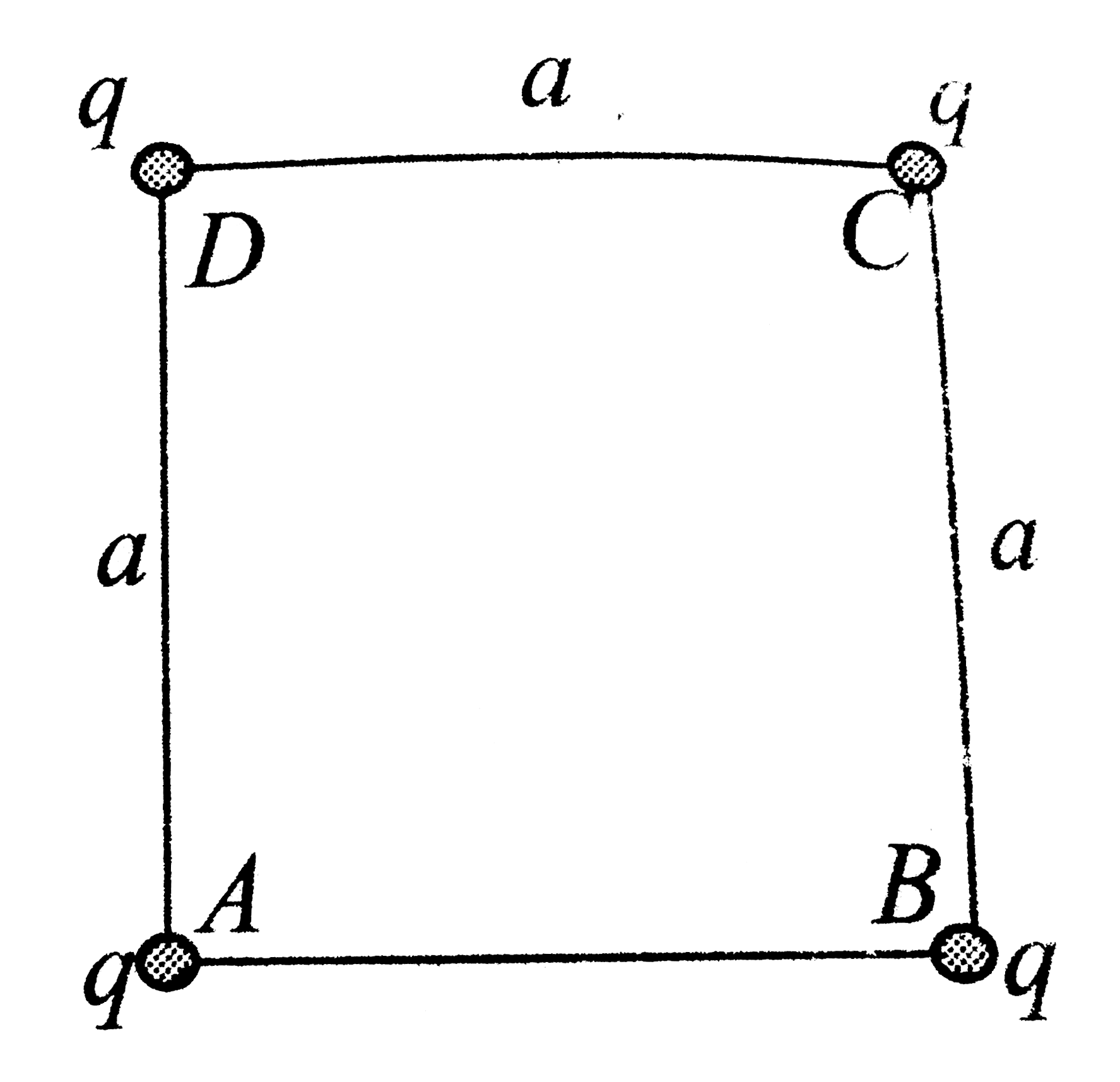A charge q1=2.00μC is located at the origin , and a charge q2=−6.00μC is located at (0,3.00)m.
(a) Find the total electric potential due to these charges at the point P hose coordinates are ( 4.00,0) m .
( b) Find the change in potential energy of the system of two charges plus a charge q3=3.00μC as the latter charge moves from infinity to point P .
To solve the problem, we need to calculate the electric potential at point P due to the two charges and then find the change in potential energy when a third charge is brought from infinity to point P.
Part (a): Finding the Total Electric Potential at Point P
1. Identify the charges and their positions:
- Charge q1=2.00μC=2.00×10−6C is located at the origin (0, 0).
- Charge q2=−6.00μC=−6.00×10−6C is located at (0, 3.00 m).
- Point P has coordinates (4.00 m, 0).
2. Calculate the distances from each charge to point P:
- Distance from q1 to P, R1=4.00m.
- Distance from q2 to P, R2=√(4.00−0)2+(0−3.00)2=√16+9=5.00m.
3. Use the formula for electric potential:
The electric potential V at a point due to a point charge is given by:
V=kqR
where k=9×109Nm2/C2 (Coulomb's constant).
4. Calculate the potential at point P due to q1:
VP1=kq1R1=9×1092.00×10−64.00=4.5×103V
5. Calculate the potential at point P due to q2:
VP2=kq2R2=9×109−6.00×10−65.00=−10.8×103V
6. Calculate the total potential at point P:
VP=VP1+VP2=4.5×103−10.8×103=−6.3×103V
Part (b): Finding the Change in Potential Energy
1. Identify the third charge:
- Charge q3=3.00μC=3.00×10−6C.
2. Calculate the change in potential energy when q3 moves from infinity to point P:
The change in potential energy ΔU is given by:
ΔU=q3⋅VP
where VP is the potential at point P calculated in part (a).
3. Substituting the values:
ΔU=3.00×10−6⋅(−6.3×103)=−1.89×10−2J
Final Answers:
- (a) The total electric potential at point P is VP=−6.3×103V.
- (b) The change in potential energy of the system is ΔU=−1.89×10−2J.
- Charge q1=2.00μC=2.00×10−6C is located at the origin (0, 0).
- Charge q2=−6.00μC=−6.00×10−6C is located at (0, 3.00 m).
- Point P has coordinates (4.00 m, 0).
- Distance from q1 to P, R1=4.00m.
- Distance from q2 to P, R2=√(4.00−0)2+(0−3.00)2=√16+9=5.00m.
The electric potential V at a point due to a point charge is given by:
V=kqR
where k=9×109Nm2/C2 (Coulomb's constant).
VP1=kq1R1=9×1092.00×10−64.00=4.5×103V
VP2=kq2R2=9×109−6.00×10−65.00=−10.8×103V
VP=VP1+VP2=4.5×103−10.8×103=−6.3×103V
- Charge q3=3.00μC=3.00×10−6C.
The change in potential energy ΔU is given by:
ΔU=q3⋅VP
where VP is the potential at point P calculated in part (a).
ΔU=3.00×10−6⋅(−6.3×103)=−1.89×10−2J
- (a) The total electric potential at point P is VP=−6.3×103V.
- (b) The change in potential energy of the system is ΔU=−1.89×10−2J.
Topper's Solved these Questions
- ELECTROSTATIC POTENTIAL AND CAPACITANCE Book:AAKASH INSTITUTE ENGLISHChapter:ELECTROSTATIC POTENTIAL AND CAPACITANCE Exercise:EXERCISE
Explore 20 Videos
- ELECTROSTATIC POTENTIAL AND CAPACITANCE Book:AAKASH INSTITUTE ENGLISHChapter:ELECTROSTATIC POTENTIAL AND CAPACITANCE Exercise:ASSIGNMENT SECTION - A
Explore 44 Videos
- ELECTROSTATIC POTENTIAL AND CAPACITANCE Book:AAKASH INSTITUTE ENGLISHChapter:ELECTROSTATIC POTENTIAL AND CAPACITANCE Exercise:SECTION-J Aakash Challengers Questions
Explore 5 Videos
- ELECTROMAGNETIC WAVESBook:AAKASH INSTITUTE ENGLISHChapter:ELECTROMAGNETIC WAVESExercise:ASSIGNMENT SECTION - D Assertion-Reason Type Questions
Explore 25 Videos
- GRAVITATION Book:AAKASH INSTITUTE ENGLISHChapter:GRAVITATION Exercise:ASSIGNMENT SECTION - D (ASSERTION-REASON TYPE QUESTIONS)
Explore 15 Videos
Similar Questions
A charge q=−2.0μC is placed at origin. Find the electric field at (3m,4m,0).
View SolutionFind out potential energy of the two point charge system having charges q1 and q2 separated by distance r.
View SolutionA point charge of 100μC is placed at 3ˆi+4ˆjm. Find the electric field intensity due to this charges at a point located at 9ˆi+12ˆjm.
View SolutionFour identical charges q are placed at the corners of a square of side a. Find the potential energy of one of the charges due to the remaining charges.
 .
.
View SolutionA point charge q1=4.00nC is placed at the origin, and a second point charge q2=−3.00nC, placed on the x-axis at x = + 20.0 cm. A third point charge q3=2.00nC is placed on the X-axis between q1,andq2. (Take as zero the potential energy of the three charges when they are infinitely far apart).
(a) What is the potential energy of the system of the three charges if q3 is placed at x= + 10.0 cm?
(b) Where should q3 be placed to make the potential energy of the system equal to zero?
View SolutionThree charges q1=1μC,q2=−2μC,andq3=−1μC are placed at A(0,0,0),B(−1,2,3,)andC(2,−1,1). Find the potential of the system of three charges at P(1,−2,−1).
View SolutionA point charge q=−8.0nC is located at the origin. Find the electric field vector at the point x=1.2m,y=−1.6m.
View SolutionA point charge q1 is held stationary at the origin. A second charge q2 is placed at a point a, and the electric potential energy of the pair of charges is −6.4×10−8J. When the second charge is moved to point b, the electric force on the charge does 4.2×10−8J of work. What is the electric potential energy of the pair of charges when the second charge is at point b?
View SolutionTwo point charges q each are fixed at (a,0) and (-a,0). A third charge Q is placed at origin. Electrons potential energy of the system will
View SolutionThree point charge q1=1μC,q2=−2μC and q3=3μC are placed at (1m,0,0),(0,2m,0) and (0,0,3m) respectively. Find the electric potential at as origin.
View Solution